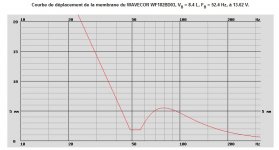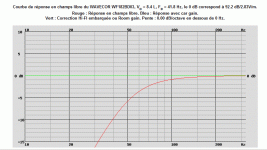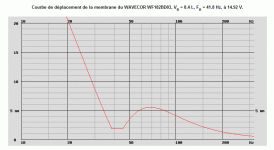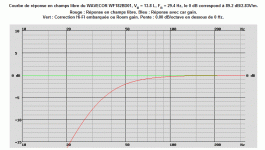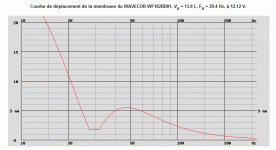I'm a bit confused right now.
I've always thought that if you add two woofers with the same specifications you get a +3dB gain. That's consistent with the results I get in WinISD and sources as this one:
http://www.epd.gov.hk/epd/noise_education/web/ENG_EPD_HTML/m1/intro_5.html
However, right now I'm putting together a crossover. I'm using Passive Crossover Designer ( http://www.pvconsultants.com/audio/crossover/pcd.htm ) and I have the proper files for the drivers.
When using one woofer and one tweeter, and looking at the numbers, I see that at the crossover point I get +6dB (e.g. the woofer is at 86 dB, the tweeter at 86 dB and it adds up to 92 db). This is consistent with information about audio crossovers from Wikipedia, see this image:
http://en.wikipedia.org/wiki/File:Linkwitz_vs_Butterworth.png
So, how come adding woofers in WinISD and "common knowledge" about how sound sources works together says +3dB and crossover facts says +6dB?
Things get even more confusing when I directly in Passive Crossover Designer choose to use 2x woofers and get +6dB compared to one woofer all the way from 10 Hz up to the crossover point, where in WinISD the same combination of two woofers gives a +3dB compared to one woofer.
Can anyone straighten this out for me?
I've always thought that if you add two woofers with the same specifications you get a +3dB gain. That's consistent with the results I get in WinISD and sources as this one:
http://www.epd.gov.hk/epd/noise_education/web/ENG_EPD_HTML/m1/intro_5.html
However, right now I'm putting together a crossover. I'm using Passive Crossover Designer ( http://www.pvconsultants.com/audio/crossover/pcd.htm ) and I have the proper files for the drivers.
When using one woofer and one tweeter, and looking at the numbers, I see that at the crossover point I get +6dB (e.g. the woofer is at 86 dB, the tweeter at 86 dB and it adds up to 92 db). This is consistent with information about audio crossovers from Wikipedia, see this image:
http://en.wikipedia.org/wiki/File:Linkwitz_vs_Butterworth.png
So, how come adding woofers in WinISD and "common knowledge" about how sound sources works together says +3dB and crossover facts says +6dB?
Things get even more confusing when I directly in Passive Crossover Designer choose to use 2x woofers and get +6dB compared to one woofer all the way from 10 Hz up to the crossover point, where in WinISD the same combination of two woofers gives a +3dB compared to one woofer.
Can anyone straighten this out for me?
I believe the reason for this confusion is that you gain 3db's for the increased woofer and 3db's for the halving of impedance. If you wired the woofers in series instead of parallel you should get no gain. Let's say you have an 8 ohm driver, if you wire it in parallel, you have the two woofers and 4 ohm impedance, so as compared with the other drivers, that driver is drawing more current, and thus, has a higher voltage sensitivity. Two 8ohm woofers in series will be 16ohm, the voltage sensitivity will be massively reduced, but you still get the 3db increase from the two woofers, giving a net gain of zero.
I'm sure there are others who can speaker more specifically about why this is, but as far as designing crossovers are concerned, that's really all you need to be concerned with. Oh keep in mind that if using the woofers for midrange as well, series will double the inductance, parallel halves it. The response will change with these two wiring configurations. For bass only it won't likely matter much (you should be using actual measurements anyway), but for midrange it will.
I'm sure there are others who can speaker more specifically about why this is, but as far as designing crossovers are concerned, that's really all you need to be concerned with. Oh keep in mind that if using the woofers for midrange as well, series will double the inductance, parallel halves it. The response will change with these two wiring configurations. For bass only it won't likely matter much (you should be using actual measurements anyway), but for midrange it will.
Well, it's a common problem that many get confused over so don't worry.
Connecting 2 drivers on the same output naturally results in a doubling of the sensitivity, meaning a +3dB gain. It doesn't matter whether you connect the speakers in series or parallel, the impact on sensitivity is the same.
However, when you parallel connect 2 driver you halve the impedance which means that for the same voltage output of the amplifier the power will also double, meaning another +3dB gain.
And naturally the opposite is true if you series connect 2 drivers and thereby double the impedance and halve the power on the same voltage output, meaning a -3dB loss.
The difference between series and parallel connections only come into play if your measuring equipment measures in volts and not in watts.
What it really means is that the same amplifier can produce 6dB higher SPL, or 4 times as loud, on 2 drivers connected in parallel as on a single driver or 2 drivers connected in series.
The differences when you calculate crossovers should be obvious. If you have a working system with a tweeter and woofer which is balanced for sensitivity, and you suddenly decide to add another woofer then you will firstly add +3dB for having 2 drivers on the woofers output. Now depending on whether you series or parallel connect you will either get a -3dB loss or a +3dB gain (or top of those +3dB from before, remember). This is because the woofer section will now draw half or twice as much power in relation to the tweeter section which is unchanged.
Connecting 2 drivers on the same output naturally results in a doubling of the sensitivity, meaning a +3dB gain. It doesn't matter whether you connect the speakers in series or parallel, the impact on sensitivity is the same.
However, when you parallel connect 2 driver you halve the impedance which means that for the same voltage output of the amplifier the power will also double, meaning another +3dB gain.
And naturally the opposite is true if you series connect 2 drivers and thereby double the impedance and halve the power on the same voltage output, meaning a -3dB loss.
The difference between series and parallel connections only come into play if your measuring equipment measures in volts and not in watts.
What it really means is that the same amplifier can produce 6dB higher SPL, or 4 times as loud, on 2 drivers connected in parallel as on a single driver or 2 drivers connected in series.
The differences when you calculate crossovers should be obvious. If you have a working system with a tweeter and woofer which is balanced for sensitivity, and you suddenly decide to add another woofer then you will firstly add +3dB for having 2 drivers on the woofers output. Now depending on whether you series or parallel connect you will either get a -3dB loss or a +3dB gain (or top of those +3dB from before, remember). This is because the woofer section will now draw half or twice as much power in relation to the tweeter section which is unchanged.
wait now, that's not fully accurate, it does matter in crossover design. If you wire them in one way over their other, the woofers will be seen by the amplifier differently as compared to the other drivers. If you don't account for this, your crossover will be wrong, the bass being either too high or two low.
Aha, I get it now, thanks for the replies!
The numbers I get from Passive Crossover Designer are based on constant voltage, while the numbers from WinISD are based on constant "wattage" (is that even a word?). I.e. 2.83V into 8 ohms is 1W, but into 4 ohms it is 2W, hence the other 3 dB gain.
I had to sleep on it, but now it all makes sense 😀
I'm just used to thinking everything in "@1W/1m", but I'm well aware of the fact that lower impedance = more power if the voltage is the same. I just didn't link those two together yesterday and it was driving me crazy. Great to get help with this kind of stuff when you get stuck!
The numbers I get from Passive Crossover Designer are based on constant voltage, while the numbers from WinISD are based on constant "wattage" (is that even a word?). I.e. 2.83V into 8 ohms is 1W, but into 4 ohms it is 2W, hence the other 3 dB gain.
I had to sleep on it, but now it all makes sense 😀
I'm just used to thinking everything in "@1W/1m", but I'm well aware of the fact that lower impedance = more power if the voltage is the same. I just didn't link those two together yesterday and it was driving me crazy. Great to get help with this kind of stuff when you get stuck!
Putting this theory into practice.....
Focal uses 3 woofers in their Electra 1038 Be 2 / 836V floor standing speakers.
Focal Electra 1038 Be: High end floorstanding hifi loudspeakers
Focal Chorus 836 V floorstanding hifi speakers for high end Home Audio system
I am hoping to build something similar using drivers from Wavecor.
Woofer: WF182BD03_04
Mid-woofer: WF120BD03_04
Tweeter: TW030WA05 to 08
If we took 3 4 ohm woofers in series we'd get 12 ohms. 2.83V at 12 ohms = 0.67W.
Each woofer is 91db@2W (2.83V @ 4 ohms) hence at 0.67W each woofer would be see 0.9V (0.22W) and hence would only be puttting out 81.5db (91-9.5db). The combination of 3 wofoers would hence be delivering around about 86.5db (81.5+4.77db) right? Hence this would match the 8 ohm WF120 midwoofer. Am I correct in assuming this?
Would a better way of looking at this would be that at 8.49V (3x 2.83V) each woofer would see 2.83V (aka 2W) and be putting out 91db each and about 95.8db (91+4.77) as a group. At 8.49V the 8 ohm mid would see 9W and hence be putting out 95.5db (86+9.5) and so would be well matched to a group of 3 4ohm woofers. Does this make sense?
What am I doing wrong?
Focal uses 3 woofers in their Electra 1038 Be 2 / 836V floor standing speakers.
Focal Electra 1038 Be: High end floorstanding hifi loudspeakers
Focal Chorus 836 V floorstanding hifi speakers for high end Home Audio system
I am hoping to build something similar using drivers from Wavecor.
Woofer: WF182BD03_04
Mid-woofer: WF120BD03_04
Tweeter: TW030WA05 to 08
If we took 3 4 ohm woofers in series we'd get 12 ohms. 2.83V at 12 ohms = 0.67W.
Each woofer is 91db@2W (2.83V @ 4 ohms) hence at 0.67W each woofer would be see 0.9V (0.22W) and hence would only be puttting out 81.5db (91-9.5db). The combination of 3 wofoers would hence be delivering around about 86.5db (81.5+4.77db) right? Hence this would match the 8 ohm WF120 midwoofer. Am I correct in assuming this?
Would a better way of looking at this would be that at 8.49V (3x 2.83V) each woofer would see 2.83V (aka 2W) and be putting out 91db each and about 95.8db (91+4.77) as a group. At 8.49V the 8 ohm mid would see 9W and hence be putting out 95.5db (86+9.5) and so would be well matched to a group of 3 4ohm woofers. Does this make sense?
What am I doing wrong?
I am hoping to build something similar using drivers from Wavecor.
Woofer: WF182BD03_04
Mid-woofer: WF120BD03_04
Tweeter: TW030WA05 to 08
I could not edit my older post but I had a related question.
Given that I will be using the 7" only till about 300Hz should I use the Wavecoor Woofer or Subwoofer?
SW182BD01_02
WF182BD03_04
The woofer's inductance is less than 0.1mH while the subwoofer's Le is 1.5mH. Also the BL/mm ratio of the subwoofer is 1/3 that of the woofer.
wait now, that's not fully accurate, it does matter in crossover design.
What Saturnus said is all true. The level or mode of wiring does matter in the xover design to have the tweeter (and now multiple woofers) remain balanced with the bass. Therefore changing the woofer section will possibly require an alteration of the tweeter section. Saturnus just did not mention that.
Later,
Wolf
See Message #8:
http://www.diyaudio.com/forums/subwoofers/52414-mutual-coupling-question.html#post585439
Regards,
WHG
http://www.diyaudio.com/forums/subwoofers/52414-mutual-coupling-question.html#post585439
Regards,
WHG
I guess the sub. Tell me why you wouldn't.I could not edit my older post but I had a related question.
Given that I will be using the 7" only till about 300Hz should I use the Wavecoor Woofer or Subwoofer?
SW182BD01_02
WF182BD03_04
The woofer's inductance is less than 0.1mH while the subwoofer's Le is 1.5mH. Also the BL/mm ratio of the subwoofer is 1/3 that of the woofer.
It looks to me you will have a blocked coil at very low frequencies >40Hz if you use the woofer (lower Xmax/Xlim) in a 21-5/2 vs 16-5/2 for sub vs woofer relation.
Attachments
Last edited:
THe JBL example deals with only 1,2 4, drivers and not wiht an odd number of smaller drivers like used in the Focal 1038Be or 836V or Polk RTi A9
Polk Audio - RTi A Series Loudspeakers
The Focal especially are interesting to me as they XO the woofer to the mid at around 250Hz which may allow for a smaller midrange. See my application requirement in post #7 above.
The 3 18cm woofers are hence about 60cm apart. 343m/60cm = which means I can expect acoustic coupling till about 550Hz. Right?
What Saturnus said is all true. The level or mode of wiring does matter in the xover design to have the tweeter (and now multiple woofers) remain balanced with the bass.
In my application (post 7) the nominal impedance of the woofers (3 x 4 ohms in series) will be 12 ohms and that of the mid and tweeter would be 8 ohms. I dont see this too much a challenge to any typlical AVR (Marantz, Denon, Pioneer etc.). Is this correct?
My assumption is that combination of 3 woofers in series would have about the same sensitivity as 1 woofer (in watt terms). Hence 1 W fed to one 8 ohm 90db woofer will produice 90db AND so will 1 W fed to 3 8 ohm 90db woofers in series. See my post 7 above and post 8 in the link below
http://www.avsforum.com/avs-vb/showthread.php?t=1299867
Like Wolf mentioned in post 6 below woofer control is not so much of a probem in most applications.
http://www.diyaudio.com/forums/multi-way/192115-series-woofers-bad-idea-okay.html
but does displacement and coupling really work for 3 woofers so far apart
http://www.diyaudio.com/forums/multi-way/67348-db-gain-series-vs-parallel-wiring.html
http://www.diyaudio.com/forums/multi-way/132766-series-connection-question.html
and another link dealing with the same question but this does not address 3 woofers in series.
http://www.diyaudio.com/forums/multi-way/189398-combined-efficiency-4-woofers-connected-2s2p.html
Another question I have is "will the 120mm midrange cope with the SPLs needed to compete with 3 180mm woofers?"
I guess the sub. Tell me why you wouldn't.
It looks to me you will have a blocked coil at very low frequencies >40Hz if you use the woofer (lower Xmax/Xlim) in a 21-5/2 vs 16-5/2 for sub vs woofer relation.
Fair question and I suppose it is my fault for not fully explaining the application. The front speakers will be part of a 7.2 HT system comprising of front towers, a center, a 4 rears (like the Focal Chorus/Electra systems linked earlier). The room is 27' x 12' with a 8' wide opening leading to a second 20' x 10' room.
However our usual use is 70% stereo (jazz, blues, rock from the 60s and 70s and some modern artists from the same genre) and 30% DVD so the alacrity of the woofers is essential. especially since the woofers are expected to operate till 250Hz. If I was crossing over at 100Hz maybe the subwoofer would be a better option.
THe WF182 has an Le of 0.9mH and a BL/Mms ratio of 6.75/16.7 and hence would be easier to excite (drive).
The SW 182 has an Le of 1.5mH and a BL/Mms ratio of 8.5/49
I have not ordered the drivers yet so if someone has a compelling rational to chose the subwoofer over the woofer I am leaning towards the woofer.
BTW the subwoofer for this system will also come from Wavecor using their SW270 and passive radiator.
edit....
The other option would be to use 3 SW182 for the bass till 150Hz or so and a single WF182 instead of a WF120 crossing over the tweeter. The reason I am not happy to go to this option is that passive LP/HP netyworks at 100-200 Hz are big and expensive and rob the speaker of it's dynamics. The only option then would be is to bi-amp the towers however no AVR I know allows me to feed the LF signal (not to be confused with the LFE signal) to an external amplifier and use it's internal amp for HF part. Does anyone know of a decently priced AVR that can do this?
Optionally I could use the LFE signal for the woofer's amplifier which means when the system is being use for stereo more the AV processor will be active. The LFE signal as I understand it is an effects signal which is only on DVD with 5.1/Dolby processing and not on regular stereo CDs.
Last edited:
I guess the sub.
I just saw the graph you posted. The WF182 it seems is not capable much below 45Hz or so. This might a compelling reason for me NOT to use the WF182 for the bass.
Now if I use three SW182 for the bass and a singple WF182 for the midbass where should I crossover? 150Hz? 200Hz? How high can I expect the SW182 to operate and still sound 'quick'?
My assumption is that combination of 3 woofers in series would have about the same sensitivity as 1 woofer (in watt terms). Hence 1 W fed to one 8 ohm 90db woofer will produice 90db AND so will 1 W fed to 3 8 ohm 90db woofers in series.
Another question I have is "will the 120mm midrange cope with the SPLs needed to compete with 3 180mm woofers?"
Now if I use three SW182 for the bass and a singple WF182 for the midbass where should I crossover? 150Hz? 200Hz? How high can I expect the SW182 to operate and still sound 'quick'?
Mods, I am not bumping my post. I am posting this to simply the questions posed in my earlier posts.
1. Will 3 4 ohm drivers in series each individually rated at 90db/1W (2Vrms) produce 90db when 0.33W (2*2/12) and hence produce about 95db at 1W (3.4vrms) is fed to the series combination of 3 drivers? If not what will be their sensitivity?
2. Given an Le of 1.5mH (for the 4ohm version) how high can I XO the SW182? 200Hz? Higher?
3. What is preferable for a floor standing speaker? We are looking to make something that resembles the Focal 1038Be and associated center and surround speakers.
http://www.focal.com/files/catalog-electra-1000-be-21.pdf
http://www.excelia-hifi.cz/focal/img/focal-electra-1038-be-inside.jpg
- 3 WF182 for the woofer section mated to a WF120 or 152 midbass and 030 tweeter?
- 3 SW 182 for the woofer section mated to a WF 182 for the midbass and a 030 tweeter.
Links to drivers....
http://www.wavecor.com/SW182BD01_02_specifications.pdf
PR182BD01
http://www.wavecor.com/WF182BD03_04_specifications.pdf
http://www.wavecor.com/WF152BD03_04_specifications.pdf
http://www.wavecor.com/WF120BD03_04_specifications.pdf
http://www.wavecor.com/TW030WA05_06_07_08_specifications.pdf
THe WF182 has an Le of 0.9mH and a BL/Mms ratio of 6.75/16.7 and hence would be easier to excite (drive).
The SW 182 has an Le of 1.5mH and a BL/Mms ratio of 8.5/49
I just saw the graph you posted. The WF182 it seems is not capable much below 45Hz or so. This might a compelling reason for me NOT to use the WF182 for the bass.
I guess the sub. Tell me why you wouldn't.
It looks to me you will have a blocked coil at very low frequencies >40Hz if you use the woofer (lower Xmax/Xlim) in a 21-5/2 vs 16-5/2 for sub vs woofer relation.
I emailed Allan Isaksen with both options:
A: 3 SW182s mated to a WF182 and TW030
B: 3 WF182s mated to a WF120 and TW030
and his advice was Option B. The smaller driver would offer better dispersion and having 3 WF182 would still produce 115db+ at 80Hz in 7 liters sealed. If a larger sealed box was used there would be some loss of protection but a few more dbs of sensitivity could be extracted.
The brute force alternate would be to use 6 WF182s in a confguration similar to the Teufel Ultima Mk2 (Teufel uses 4 PRs of the 6 shown).
http://www.teufel.de/media/oart_0/oart_u/k2653/thumbs/8243_32765.jpg
Yes, for stereo I would go with a full range speaker (20Hz-20KHz).However our usual use is 70% stereo (jazz, blues, rock from the 60s and 70s and some modern artists from the same genre)...
I like paper cones better also.
> 60Hz.I just saw the graph you posted. The WF182 it seems is not capable much below 45Hz or so. This might a compelling reason for me NOT to use the WF182 for the bass.
...
Wrong choice.
WAVECOR WF182BD03, VB = 8.4 L, FB = 41.8 Hz, 0 dB=>92.2 dB2.83Vm.
F3=65 Hz, F6=50 Hz, F12=36 Hz
WAVECOR WF182BD03, VB = 8.4 L, FB = 41.8 Hz, w.14.92 V.
Attachments
Last edited:
Wavecor WF182 vs SW182
Thank you Inductor. Did you mean that you recommend the SW182BD instead of the WF182BD driver?
I was using the curves found here Voice Coil - Voice Coil April 2011
In about 7 liters sealed the WF182 was uable to 80Hz. In about 11 liters vented the WF182 was usable to 45Hz.
See this review http://www.wavecor.com/Angara.pdf
Since I am building a floor standing speaker I can go upto 14 liters per woofer (0.5 cu. ft). The woofer section of the cabinet will have internal dimensions about 30" tall, 14-16" deep and 6-7" wide. Take away 20% for bracing and driver displacement and still have 40-45 liters.
Yesterday when I got Allan's reply (chosing the WF182 over the SW182) I contemplated something like this.
Newtronics Temperance Loudspeakers listening test [English]
Temperance Building Instruction
Sure the SW182 is less stressed (more Xmax) than the WF182 and can go lower but Allan believes that for the midrange the WF120 is better than the WF182 (used if the SW182 was to be used for bass). Let me email him again and ask. What software did you use to simulate the VB of 8.4 liters and F3 of 60Hz?
Mods: the last few posts have been more about a Wavecor based speaker I am hoping to make than the original topic. Fell free to move posts to a seperate thread if you need to. Thanks and sorry for going off topic.
> 60Hz.
Wrong choice.
WAVECOR WF182BD03, VB = 8.4 L, FB = 41.8 Hz, 0 dB=>92.2 dB2.83Vm.
F3=65 Hz, F6=50 Hz, F12=36 Hz
WAVECOR WF182BD03, VB = 8.4 L, FB = 41.8 Hz, w.14.92 V.
Thank you Inductor. Did you mean that you recommend the SW182BD instead of the WF182BD driver?
I was using the curves found here Voice Coil - Voice Coil April 2011
In about 7 liters sealed the WF182 was uable to 80Hz. In about 11 liters vented the WF182 was usable to 45Hz.
See this review http://www.wavecor.com/Angara.pdf
Since I am building a floor standing speaker I can go upto 14 liters per woofer (0.5 cu. ft). The woofer section of the cabinet will have internal dimensions about 30" tall, 14-16" deep and 6-7" wide. Take away 20% for bracing and driver displacement and still have 40-45 liters.
Yesterday when I got Allan's reply (chosing the WF182 over the SW182) I contemplated something like this.
Newtronics Temperance Loudspeakers listening test [English]
Temperance Building Instruction
Sure the SW182 is less stressed (more Xmax) than the WF182 and can go lower but Allan believes that for the midrange the WF120 is better than the WF182 (used if the SW182 was to be used for bass). Let me email him again and ask. What software did you use to simulate the VB of 8.4 liters and F3 of 60Hz?
Mods: the last few posts have been more about a Wavecor based speaker I am hoping to make than the original topic. Fell free to move posts to a seperate thread if you need to. Thanks and sorry for going off topic.
Last edited:
If I could time travel I would chose the discontinued version.Thank you Inductor. Did you mean that you recommend the SW182BD instead of the WF182BD driver?
Hey, what I would do first, chose your main driver, where is for 5.1, 7.1, 2.1, stereo or what ever and then go with the flow. Don't go in circles like Focal this Focal that, "Mid-woofer: WF120BD03_04" this, mid woofer "WF182BD03_04" that... small, big, more one and more two...
WAVECOR WF182BD01, VB = 13.8 L, FB = 29.4 Hz, le 0 dB correspond à 89.2 dB2.83Vm. F3=44 Hz, F6=33 Hz, F12=24 Hz_discontinued
WAVECOR WF182BD01, VB = 13.8 L, FB = 29.4 Hz, à 12.12 V._discontinued
Attachments
If I could time travel I would chose the discontinued version.
Hey, what I would do first, chose your main driver, where is for 5.1, 7.1, 2.1, stereo or what ever and then go with the flow. Don't go in circles like Focal this Focal that, "Mid-woofer: WF120BD03_04" this, mid woofer "WF182BD03_04" that... small, big, more one and more two...
WAVECOR WF182BD01, VB = 13.8 L, FB = 29.4 Hz, le 0 dB correspond à 89.2 dB2.83Vm. F3=44 Hz, F6=33 Hz, F12=24 Hz_discontinued
WAVECOR WF182BD01, VB = 13.8 L, FB = 29.4 Hz, à 12.12 V._discontinued
1. Inductor, thanks for all the help. I really appreciate your advice. How come you know so much about Wavecor drivers. Have you used any of them? I happened to chance upon them at an affordbale price (about the same price as SEAS Prestige).
2. I just like the look of the Focal Chorus/Electra series so wanted to make speakers (floor standing, rear, center and bookshelf) that looked similar.
3. Yes you are right. I should first narrow down my main driver (which I define as 200-3000Hz). WF120 is smaller and has nicer respnse than the 182 above 2k (till about 5/6k). Does it make sense then to use the SW182 for the bass and the WF120 for the mid (say crossing over at 200-300Hz)? Would I run into SPL limitations with the WF120 (if used above 200Hz)? Should I then consider the WF152 instead?
Voice Coil - Voice Coil December 2010
WF152BD03_04
now I am really confused WF120, 152 or 182?😕
Off topic.....
4. I noticed that the SW182 is only about 80db/1W (below 200Hz). Putting 3 in series will not raise the sensitivity (but will raise the ammount of power and hence max SPL they can produce). Hence if I were to use the SW182 in a passive 3 way tower the rest of the drviers would have to be padded down to match the sensitivity of the SW182. Or the SW182 would have to be powered by a seperate amplifier.
SW182BD01_02
5. On the other hand the WF182 is about 87db/1W (below 200hz) and the WF152 is 88db/1W (above 200hz) and these 2 drivers match well in a passive system.😎
- Home
- Loudspeakers
- Multi-Way
- Woofers working together, +3dB or +6dB?
